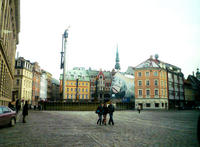You are in: Europe -> Latvia -> Historic Centre of Riga, and traditional search or Image Gallery will yield results of this site only
Historic Centre of Riga
| Site number: | 852 |
|
| Type of site: | Cultural | |
| Date: | 13-15th century | |
| Date of Inscription: | 1997 | |
| Location: | Europe, Latvia, City of Riga | |
Up to 75 images are shown here. Click on each for more details or on Image Gallery for more images.
Six official UN languages:
Arabic,
Chinese,
English,
French,
Russian,
Spanish
Other languages: Basque, Belarusian, Bosnian, Breton, Bulgarian, Catalan, Chuvash, Croatian, Czech, Danish, Dutch, Esperanto, Estonian, Finnish, Galician, Georgian, German, Greek, Hebrew, Hungarian, Italian, Japanese, Korean, Latvian, Lithuanian, Norwegian-bokmål, Norwegian-nynorsk, Polish, Portuguese, Romanian, Serbian, Slovak, Swedish, Turkish, Ukrainian, Vietnamese, Welsh, Serbo-Croatian
Other languages: Basque, Belarusian, Bosnian, Breton, Bulgarian, Catalan, Chuvash, Croatian, Czech, Danish, Dutch, Esperanto, Estonian, Finnish, Galician, Georgian, German, Greek, Hebrew, Hungarian, Italian, Japanese, Korean, Latvian, Lithuanian, Norwegian-bokmål, Norwegian-nynorsk, Polish, Portuguese, Romanian, Serbian, Slovak, Swedish, Turkish, Ukrainian, Vietnamese, Welsh, Serbo-Croatian
| Description: | A major centre of the Hanseatic League, Riga’s prosperity stemmed from the trade with central and Eastern Europe in the 13th–15th centuries. Its medieval centre’s urban fabric indicates this prosperity; though in succeeding centuries it has lost many of its earliest buildings to the destructions of fire and war. Riga developed into a significant economic centre when it saw the laying out of its suburbs around its medieval town during the 19th century, primarily imposing wooden buildings were erected in neoclassical style and then in Jugendstil. Riga is commonly renowned for the finest collection of art nouveau buildings in all of Europe. --WHMNet paraphrase from the description at WHC Site, where additional information is available. | |
| Riga (Latvian: Rīga) the capital of Latvia, is situated on the Baltic Sea coast on the mouth of the river Daugava. Riga is the largest city in the Baltic States. The Historic Centre of Riga has been declared a UNESCO World Heritage Site, and the city is particularly notable for its extensive Art Nouveau (Jugendstil) architecture, comparable in significance only with Vienna and Saint Petersburg. Riga served as a gateway to trade with the Baltic tribes and with Russia. In 1282 Riga became a member of the Hanseatic League (German Hanse, English Hansa). The Hansa developed out of an association of merchants into a loose trade and political union of North German and Baltic cities and towns. The Hansa was instrumental in giving Riga economic and political stability, thus providing the city with a strong foundation which endured the political conflagrations that were to come, down to modern times. As the influence of the Hansa waned, Riga became the object of foreign military, political, religious and economic aspirations. --Wikipedia. Text is available under the Creative Commons Attribution-ShareAlike License. | ||
| Source: | http://whc.unesco.org/en/list/852 | |
| Reference: | 1. UNESCO World Heritage Center, Site Page. | |












































































